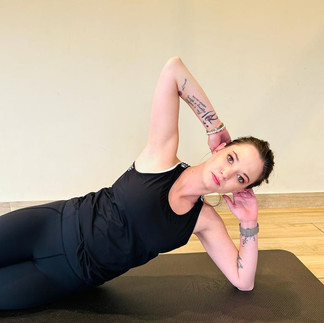The Shoulder and the Shoulder Girdle
- Chi Ingledew
- Aug 21, 2023
- 2 min read
The shoulder and shoulder girdle are integral components of the body's upper extremity, playing a vital role in everyday activities and movement. As a Pilates instructor, understanding the complexities of the shoulder and shoulder girdle is essential for guiding you towards optimal alignment, strength, and mobility in this area.
The shoulder girdle is a complex system consisting of the scapulae (shoulder blades), clavicles (collarbones), and the connecting muscles, ligaments, and joints. It serves as the foundation for the shoulder joint, allowing for a wide range of movements, including flexion, extension, abduction, adduction, internal rotation, and external rotation.
One of the key aspects to consider when working with the shoulder girdle in Pilates is the importance of stability and mobility. The scapulae need to have a stable base for the shoulder joint to function optimally. This stability is achieved through the coordination of the surrounding muscles, such as the trapezius, serratus anterior, rhomboids, and the rotator cuff muscles (supraspinatus, infraspinatus, teres minor, and subscapularis). These muscles work together to maintain proper scapular alignment and control the movements of the shoulder girdle.
In Pilates, exercises that focus on scapular stabilisation and mobility are crucial for maintaining healthy shoulder function. Movements like scapular retractions, protraction, elevation, and depression can help strengthen and improve the control of the muscles surrounding the scapulae. By integrating these exercises into a Pilates practice, you can develop better body awareness and enhance your ability to stabilise and move the shoulder girdle effectively.
The shoulder joint itself, also known as the glenohumeral joint, is a ball-and-socket joint formed by the head of the humerus and the glenoid fossa of the scapula. It is a highly mobile joint that allows for a wide range of movements. However, this mobility also makes the shoulder joint prone to instability and injury. Pilates exercises that focus on strengthening the muscles surrounding the shoulder joint, such as the deltoids, rotator cuff muscles, and pectorals, can help improve stability and prevent injuries.
Proper alignment of the shoulder and shoulder girdle is paramount in Pilates. Misalignment or imbalances in this area can lead to compensatory movements, limited range of motion, and increased risk of injuries. At Enerchi Fitness we pay close attention to your posture and shoulder alignment, ensuring that the shoulder girdle is properly aligned and the scapulae are positioned correctly on the rib cage.
Breathing is another crucial aspect to consider when working with the shoulder and shoulder girdle in Pilates. Encouraging you to engage in deep, diaphragmatic breathing while performing exercises can help facilitate proper alignment, release tension in the neck and shoulders, and promote relaxation.
The shoulder and shoulder girdle are complex structures that require attention and care. By focusing on stability, mobility, alignment, and proper breathing techniques, we can guide you towards optimal shoulder function. Strengthening the muscles surrounding the shoulder girdle, improving scapular control, and promoting healthy movement patterns can lead to enhanced posture, increased range of motion, and reduced risk of shoulder-related injuries. Join us at Enerchi Fitness for some Pilates and let’s get you moving.
Written by Rebecca Clare Maddox






















